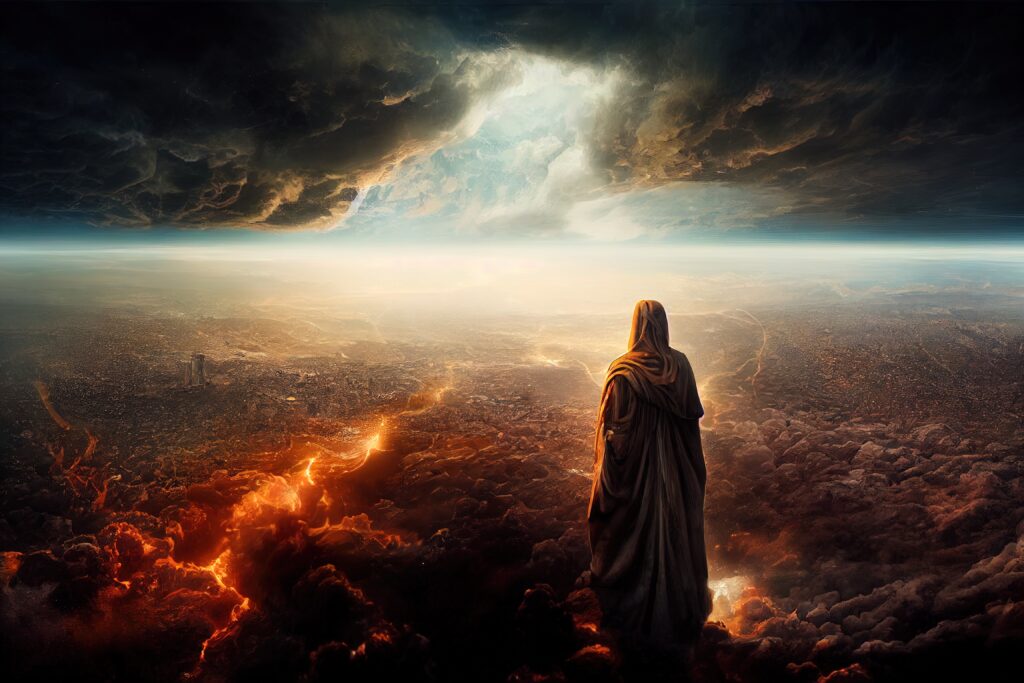
They Stood on their Feet.
“And their dead bodies will lie on the street of the great city which spiritually is called Sodom and Egypt, where also their Lord was crucified. Those from the peoples, tribes, languages, and nations will look at their dead bodies for three and a half days, and will not allow their dead bodies to be laid in a tomb. And those who live on the earth will rejoice over them and celebrate; and they will send gifts to one another, because these two prophets tormented those who live on the earth. And after the three and a half days, the breath of life from God came into them, and they stood on their feet; and great fear fell upon those who were watching them.” – Revelation 11:8-11 NASB.
The text says that Sodom is a figurative symbol. Sodom was a place of immoral degradation, and was destroyed by fire – a sign of the end times. Egypt is a symbol of atheistic arrogance and non-belief, another sign of the end.
On January 21, 1793, the French Assembly voted to abolish religion in France. However, 3 ½ years later the same body voted to reinstate it on June 10, 1796. In that short period, they learned that reason by itself would not work.
The Book of Revelation teaches us that the triumph of evil is always short-lived.
In the end, the people of God will be vindicated in the sight of all who have despised and abused them (Rev 20:7-10). We need the patience to wait for God’s vindication. The reign of terror in France that saw the burning of the Bible and the extermination of Christianity lasted exactly 3 ½ years. Following the French revolution, we saw the establishment of Bible societies, translating and distributing the word of God to the world!
According to our text, the emotions of “those who live on the earth” shifted suddenly from great rejoicing to great fear. In both cases, the emotions were related to the future. When the two witnesses were dead, people foresaw no “torment” in their future. But the resurrection of the witnesses (the word of God) brought great fear.
Those who are on God’s side don’t have to be afraid of the future. We already know that the plagues at the end will not harm those who are sealed by the Holy Spirit. We have nothing to fear for the future except we forget how God has led us in the past.
Revelation 11 contains allusions to Moses and Elijah. Moses turned water into blood, struck Egypt with other plagues and led Israel on their 42-stage journey from Egypt to the promised land. Elijah had prevented rain for 3 ½ years. Both men were witnesses to Jesus’ divinity as revealed in the transfiguration (Matt 17:1ff). Elijah and Moses both had special resurrections and are in heaven now. Elijah represenst those who will be translated alive at the second coming without seeing death, and Moses represents those who will die in the Lord and be resurrected at the second coming.
The testimony from the mouths of two witnesses is said to be powerful like fire(11:5), which are two descriptions of God’s word from the Old Testament. (Exodus 24:7, Numbers 11:1, and 16:35.)
John, in our text, saw the fate of the two witnesses, where the whole world is celebrating (note the four-fold language again of people. tribes, languages and nations) but then the 3 ½ years runs its course indicating trouble. 3 ½ is a broken 7. Seven indicates rest and 3 ½ unrest. Sodom and Egypt were evil places under divine judgment, from which God rescued His people through dramatic intervention. It was also mentioned figuratively as the place where Christ died – Jerusalem. Even Godly places can abandon true worship.
The three-and-a-half days sound like a miniature of the three-and-a-half years the two witnesses were clothed in sackcloth. This dynamic illustrates the day-year equivalence in the minds of ancient Hebrew thinkers. This kind of year-day thinking in the Bible laid the groundwork for the year-day principle that was introduced into prophetic interpretation during the Protestant Reformation of the 15th and 16th centuries.
The sackcloth represents the lack of respect with which people regarded them, the obscurity in which they operated. This obscurity and disrespect here intensifies with their death and bodily exposure. Exposing dead bodies was a great disgrace in the ancient world and thus a sign of gross disrespect as was demonstrated in the atheistic revolution in France.
We are also reminded of the three days Christ spent in the tomb, so this scene is probably an allusion to Christ’s death and burial. He was crucified in the “midst of the week” (Dan 9:27), so the three and a half days may also allude to Daniel 9.
The actions of some from every “people, language, and nation” produce a bitter result that reminds the reader of the bitterness that occurred when John ate the scroll (Rev 10:8-11)– he must prophesy again. A similar series of terms to those used in 10:11 describe the people who reject the message. The bitterness involves the fact that the message is rejected by the very people it was intended for. It was an extremely painful rejection and a gross indignity to be refused burial.
